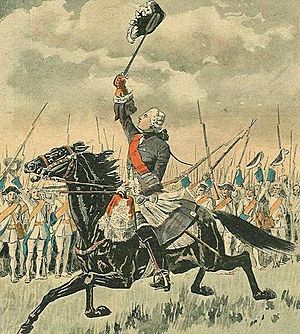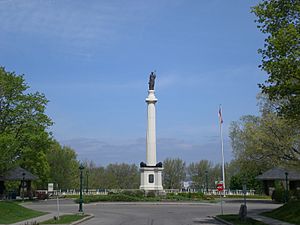Battle of Sainte-Foy facts for kids
Quick facts for kids Battle of Sainte-Foy |
|||||||
|---|---|---|---|---|---|---|---|
| Part of the Seven Years' War the French and Indian War |
|||||||
 The Battle of Sainte-Foy by George B. Campion, watercolour. |
|||||||
|
|||||||
| Belligerents | |||||||
| Commanders and leaders | |||||||
| Strength | |||||||
| 5,000 regulars and militia | 3,800 regulars 27 guns |
||||||
| Casualties and losses | |||||||
| 193 killed 640 wounded |
259 killed 829 wounded |
||||||
The Battle of Sainte-Foy (also called the Battle of Quebec) was a major fight during the Seven Years' War. It happened on April 28, 1760, near Quebec, which was then part of New France. This battle was a victory for the French army, led by the Chevalier de Lévis. They defeated the British army, commanded by General Murray.
This battle was even more intense and bloody than the famous Battle of the Plains of Abraham that happened the year before. Many soldiers were hurt or killed on both sides. The British initially pushed forward, but their cannons got stuck in the mud and melting snow. The fight became a close-up struggle for two hours. As more French soldiers joined, they surrounded the British. General Murray had to pull his troops back to Quebec, leaving their cannons behind. The French then used these captured cannons against the city.
Contents
Why did the Battle of Sainte-Foy happen?
New France faces challenges
Before this battle, New France had a tough time in the French and Indian War. In 1758, the British captured their strong fortress at Louisbourg. They also took over Fort Duquesne. Things got worse in 1759. The British captured Fort Carillon and Fort Niagara. Then, the important city of Quebec fell after a long siege and a big battle.
French army regroups
After losing Quebec, the French army gathered in Montreal. Their new leader was General Chevalier de Lévis. Meanwhile, the British army stayed in Quebec. They faced many problems during the winter of 1759-1760. Many soldiers were hungry or sick with scurvy. Living in the city, which was largely destroyed, was also very hard.
Lévis plans to retake Quebec
In April 1760, Lévis marched back to Quebec. He had an army of over 7,000 men. This included French soldiers, local Canadian militia, and First Nations warriors. He hoped to surround Quebec and force the British to give up. He expected a French fleet to arrive by sea and help him.
Murray's risky decision
General James Murray was in charge of the British in Quebec. He felt his army was too small to defend the city walls properly. The walls had not been fixed since the British captured the town. So, he decided to take a chance. He led about 3,800 men and over twenty cannon out of the city. They went to the same spot where the 1759 battle had happened. Instead of waiting for the French, Murray decided to attack first.
How the Battle of Sainte-Foy was fought
Armies prepare for battle
Lévis commanded about 6,910 soldiers. This included regular French troops and local Canadian militia. Only about 5,000 of his men and three cannons were on the battlefield at Sainte-Foy.
Murray's British force had 3,886 men. They were mostly regular soldiers. To cover the wide battlefield, the British soldiers stood in two lines. They had gaps between them, which was not their usual tight formation. Their cannons supported them. One British soldier wrote that their army was "a poor pitiful handful of half starved scorbutic skeletons." This shows how tough their winter had been.
The battle begins
Murray saw that the French army was still getting ready. He decided to attack them before they were fully prepared. As the British moved forward, Lévis pulled back some of his troops into nearby woods. The British light infantry (fast-moving soldiers) pushed some French soldiers out of a windmill. But as they chased them, they ran into trouble. French troops attacked them fiercely.
Murray sent in more British soldiers to help. A tough fight for the windmill continued. On the other side, British troops captured some small forts. But then Lévis launched a strong counterattack. Murray sent in his last reserve troops to stop this attack. He also moved soldiers from the center of his line to help.
British retreat
However, the British left side eventually gave way. They had lost many soldiers. The entire British line then began to collapse. Lévis later said he tried to cut off the British retreat to Quebec. But one of his brigades (a group of soldiers) went the wrong way. This allowed the British to escape.
At first, the many British cannons kept the French attacks away. But the French attack gained strength when the British guns started to run out of ammunition. The British ammunition carts had gotten stuck in the deep snow. As the British retreated, they had to leave their cannons behind. They made them unusable so the French could not use them easily.
What happened after the battle?
Many casualties
The Battle of Sainte-Foy was very bloody. The British army lost 292 soldiers killed, 837 wounded, and 53 captured. This was a total of 1,182 casualties. The French lost 833 men, with 193 killed and 640 wounded. Some British units lost over a third of their men. Three-quarters of the officers from the Fraser Highlanders were killed or wounded. This battle is known as one of the bloodiest ever fought in Canada.
Quebec holds out
Even though Lévis won the battle, he could not take Quebec back. The British soldiers went behind the city's strong walls. They held out against Lévis's weak siege. They waited for help to arrive by sea in May.
The French fleet never came. France's navy had been badly beaten in a battle called Quiberon Bay the previous fall. Also, the few supply ships sent from France were lost in the Bay of Chaleur. Then, British warships arrived at Quebec. They quickly destroyed Lévis's support ships on the Saint Lawrence River. Lévis realized he couldn't win. He quickly ended the siege and retreated to Montreal. In September, he surrendered to a huge British force that came from three different directions. This ended the major fighting in Canada during the Seven Years' War.
Remembering the Battle of Sainte-Foy
A monument called "The Monument des Braves" was built in Quebec in 1863. It remembers the Battle of Sainte-Foy. This was part of a time between 1850 and 1930 when many monuments were built across Canada. These monuments aimed to create good memories of the past. They also tried to help English-speaking and French-speaking Canadians feel closer to each other.
See also
 In Spanish: Batalla de Sainte-Foy para niños
In Spanish: Batalla de Sainte-Foy para niños



